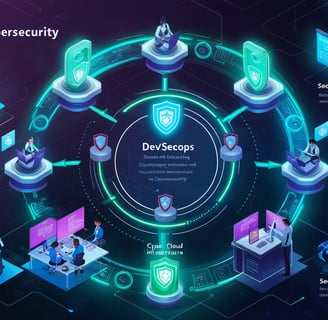Implementing DevSecOps: A Comprehensive Guide to Secure Software Development
In today’s fast-paced digital landscape, the need for secure software development has never been more critical. With cyberattacks growing in sophistication and frequency, organizations must integrate security into every phase of the software development lifecycle (SDLC). This is where DevSecOps comes into play. DevSecOps is the practice of embedding security into the DevOps process, ensuring that security is a shared responsibility across development, operations, and security teams. This blog will provide a detailed guide on implementing DevSecOps, covering coding securely, the DevSecOps process flow, best practices, CI/CD pipeline security, container and web application security, and more. The target audience includes CISOs, SOC managers, Cybersecurity directors, leadership, and entrepreneurs who are looking to strengthen their organization’s security posture.
CYBERSECURITY


# Why DevSecOps is Required
Rising Cyber Threats: The increasing complexity of cyberattacks, such as ransomware, supply chain attacks, and zero-day vulnerabilities, demands a proactive approach to security.
Shift-Left Security: Traditional security practices often treat security as an afterthought. DevSecOps shifts security "left" in the SDLC, addressing vulnerabilities early in the development process.
Regulatory Compliance: Regulations like GDPR, HIPAA, and PCI-DSS require organizations to implement robust security measures.
Speed and Agility: DevSecOps enables organizations to deliver secure software faster, without compromising on security.
Cost Efficiency: Fixing vulnerabilities in production is far more expensive than addressing them during development.
# DevSecOps Process Flow
The DevSecOps process integrates security into every stage of the DevOps pipeline. Here’s a high-level overview of the process flow:
Plan: Define security requirements, threat models, and compliance goals.
Code: Write secure code using best practices and perform static code analysis.
Build: Integrate security tools into the build process to detect vulnerabilities.
Test: Conduct dynamic application security testing (DAST), interactive application security testing (IAST), and software composition analysis (SCA).
Release: Automate security checks in the CI/CD pipeline before deployment.
Deploy: Use infrastructure-as-code (IaC) security tools to ensure secure configurations.
Operate: Monitor applications and infrastructure for security incidents in real time.
Monitor: Continuously monitor for threats and vulnerabilities using SIEM, SOAR, and other tools.
# How to Code Securely
Secure coding is the foundation of DevSecOps. Here are some best practices:
Input Validation: Validate all user inputs to prevent injection attacks (e.g., SQL injection, XSS).
Authentication and Authorization: Implement strong authentication (e.g., MFA) and role-based access control (RBAC).
Encryption: Encrypt sensitive data at rest and in transit using strong encryption algorithms.
Error Handling: Avoid exposing sensitive information in error messages.
Secure APIs: Use OAuth2, API gateways, and rate limiting to secure APIs.
Dependency Management: Regularly update third-party libraries and dependencies to patch vulnerabilities.
Code Reviews: Conduct peer reviews to identify security flaws.
# Best Practices for Implementing DevSecOps
Automate Security Testing: Integrate SAST, DAST, and SCA tools into the CI/CD pipeline.
Adopt Infrastructure-as-Code (IaC): Use tools like Terraform or CloudFormation to ensure secure infrastructure configurations.
Implement Secrets Management: Use tools like HashiCorp Vault or AWS Secrets Manager to securely manage credentials.
Container Security: Scan container images for vulnerabilities and enforce least-privilege principles.
Continuous Monitoring: Use SIEM and SOAR tools to detect and respond to threats in real time.
Threat Modeling: Identify potential threats and vulnerabilities during the design phase.
Security Training: Regularly train developers and operations teams on secure coding and security best practices.
# CI/CD Pipeline Security
The CI/CD pipeline is the backbone of DevSecOps. Here’s how to secure it:
Static Application Security Testing (SAST): Analyze source code for vulnerabilities during the build phase.
Dynamic Application Security Testing (DAST): Test running applications for vulnerabilities like SQL injection and XSS.
Software Composition Analysis (SCA): Identify vulnerabilities in third-party libraries and dependencies.
Infrastructure-as-Code (IaC) Security: Scan IaC templates for misconfigurations.
Secrets Scanning: Detect hardcoded credentials in the codebase.
Artifact Signing: Sign build artifacts to ensure their integrity.
# Container Security
Containers are a key component of modern applications, but they also introduce security risks. Here’s how to secure them:
Image Scanning: Scan container images for vulnerabilities before deployment.
Least Privilege: Run containers with the minimum required permissions.
Network Segmentation: Isolate container networks to limit lateral movement.
Runtime Security: Monitor containers for suspicious activity during runtime.
Immutable Infrastructure: Use immutable containers to prevent unauthorized changes.
# Web Application Security
Web applications are a common target for attackers. Here’s how to secure them:
Web Application Firewalls (WAF): Deploy WAFs to filter malicious traffic.
Secure Headers: Use HTTP security headers like CSP, HSTS, and X-Content-Type-Options.
Session Management: Implement secure session management practices.
Content Security Policy (CSP): Prevent XSS attacks by defining trusted sources for content.
Regular Penetration Testing: Conduct regular pen tests to identify vulnerabilities.
# Key Tools for DevSecOps
SAST Tools: SonarQube, Checkmarx, Fortify.
DAST Tools: OWASP ZAP, Burp Suite.
SCA Tools: WhiteSource, Snyk.
Container Security Tools: Aqua Security, Anchore.
Secrets Management: HashiCorp Vault, AWS Secrets Manager.
CI/CD Security: Jenkins, GitLab CI, CircleCI with integrated security plugins.
Monitoring Tools: Splunk, ELK Stack, Datadog.
# Conclusion
DevSecOps is no longer optional—it’s a necessity for organizations that want to deliver secure software at scale. By integrating security into every phase of the SDLC, organizations can reduce risks, achieve compliance, and build trust with their customers.
Call to Action:
Evaluate your current DevOps pipeline and identify gaps in security.
Invest in DevSecOps tools and training for your teams.
Collaborate with leadership to build a security-first culture.
For expert guidance on implementing DevSecOps and enhancing your cybersecurity posture, contact thefridrick.in. Let’s build a safer digital future together!
